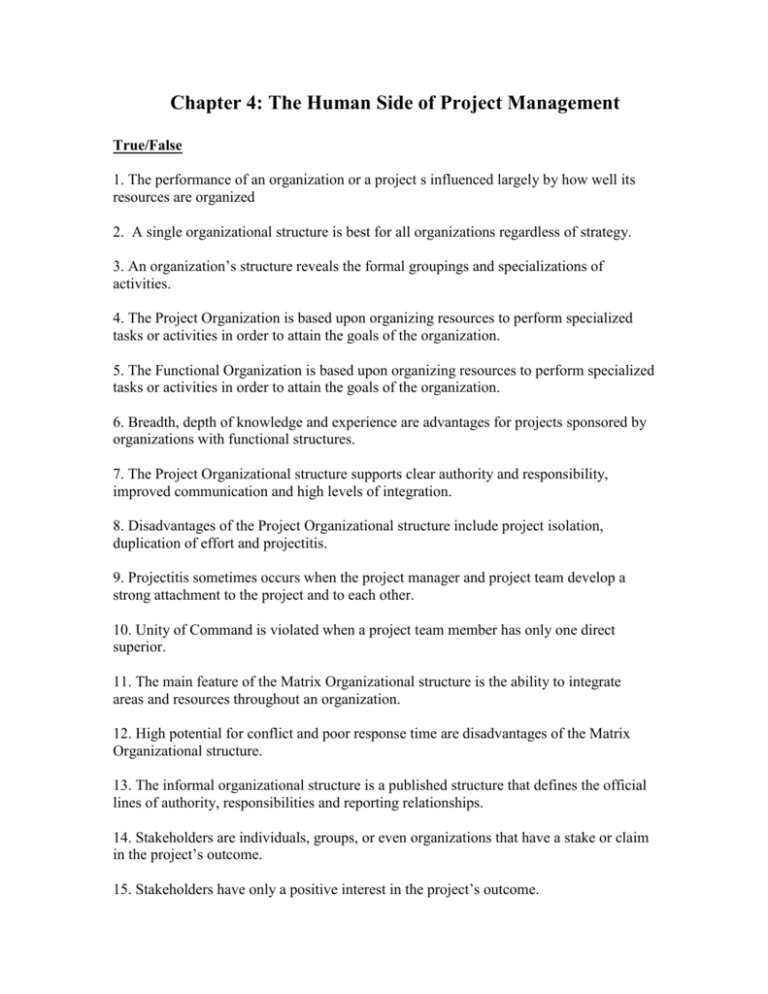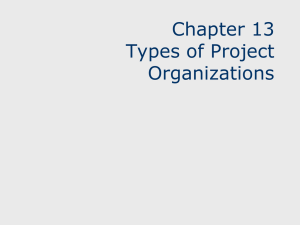Chapter 4: The Human Side of Project Management
advertisement

Chapter 4: The Human Side of Project Management True/False 1. The performance of an organization or a project s influenced largely by how well its resources are organized 2. A single organizational structure is best for all organizations regardless of strategy. 3. An organization’s structure reveals the formal groupings and specializations of activities. 4. The Project Organization is based upon organizing resources to perform specialized tasks or activities in order to attain the goals of the organization. 5. The Functional Organization is based upon organizing resources to perform specialized tasks or activities in order to attain the goals of the organization. 6. Breadth, depth of knowledge and experience are advantages for projects sponsored by organizations with functional structures. 7. The Project Organizational structure supports clear authority and responsibility, improved communication and high levels of integration. 8. Disadvantages of the Project Organizational structure include project isolation, duplication of effort and projectitis. 9. Projectitis sometimes occurs when the project manager and project team develop a strong attachment to the project and to each other. 10. Unity of Command is violated when a project team member has only one direct superior. 11. The main feature of the Matrix Organizational structure is the ability to integrate areas and resources throughout an organization. 12. High potential for conflict and poor response time are disadvantages of the Matrix Organizational structure. 13. The informal organizational structure is a published structure that defines the official lines of authority, responsibilities and reporting relationships. 14. Stakeholders are individuals, groups, or even organizations that have a stake or claim in the project’s outcome. 15. Stakeholders have only a positive interest in the project’s outcome. 16. An IT project manager’s technical knowledge is much more important that his or her ability to communicate with people. 17. Project team members should be chosen based upon their technology skills, business/organization skills and interpersonal skills. 18. A work group has a single leader in control that makes most of the decisions, delegates to subordinates and monitors the progress of the assigned tasks. 19. Real teams are defined as having a large number of people with similar skills and experiences. 20. Real teams tend to have a commitment to a common purpose and performance goals. 21. Traditional teams tend to accept the project as it is first defined and do not challenge preconceived notions about the problem or opportunity and what they must do. 22. The four phases of a learning cycle include understand and frame the problem, plan, act, reflect and learn. 23. The project environment includes not only the physical space where the team will work, but also the project culture as well. 24. Culture reflects the values and norms of the project team. 25. A study group would be an example of a work group. Multiple Choice 1. High level of integration, improved communication, increased project focus, higher potential for conflict and poorer response time are advantages and disadvantages of: a) The Functional Organization b) The Matrix Organization c) The Project-Based Organization d) The Informal Organization e) The Formal Organization Answer: 2. Increased flexibility, breadth and depth of knowledge and experience, less duplication, determining authority and responsibility, poor response time and poor integration are advantages and disadvantages of: a) The Functional Organization b) The Matrix Organization c) The Project-Based Organization d) The Informal Organization e) The Formal Organization Answer: 3. Clear authority and responsibility, improved communication, high level of integration, project isolation, duplication of effort and projectitis are advantages and disadvantages of: a) The Functional Organization b) The Matrix Organization c) The Project-Based Organization d) The Informal Organization e) The Formal Organization Answer: 4. Unity of command violations are most often associated with: a) The Functional Organization b) The Matrix Organization c) The Project-Based Organization d) The Informal Organization e) The Formal Organization Answer: 5. The more traditional organizational form best describes: a) The Functional Organization b) The Matrix Organization c) The Project-Based Organization d) The Informal Organization e) The Formal Organization Answer: 6. The structure that reveals most clearly how individuals in an organization relate is the: a) The Functional Organization b) The Matrix Organization c) The Project-Based Organization d) The Informal Organization e) The Formal Organization Answer: 7. The most complex organizational structure is the: a) The Functional Organization b) The Matrix Organization c) The Project-Based Organization d) The Informal Organization e) The Formal Organization Answer: 8. Which of the following attributes is least important for project managers?: a) Ability to communicate with people. b) Ability to deal with people. c) Ability to create and sustain relationships. d) Ability to learn new technical skills. e) Ability to organize. Answer: 9. Radical teams are most likely to: a) accept background information at face value. b) approach projects in a linear fashion. c) provide run-of-the-mill solutions. d) get to the root of the matter. e) focus on the schedule and budget. Answer: 10. The phases of a learning cycle include all of the following except: a) Act b) Assess risk c) Reflect and learn d) Plan e) Understand and frame problem Answer: 11. The attributes commonly used in stakeholder evaluations include: a) speed b) depth c) breadth d) all of the above e) none of the above Answer: Short Answer (From End of Chapter Review Questions) 1. What is the relationship between an organization’s strategy and organizational structure? 2. What is meant by the formal organization? 3. Why is it important for a project manager to understand the formal organization? 4. Describe the functional organizational structure. 5. What are some challenges for IT projects under the functional organizational structure? 6. What are some opportunities for IT projects under the functional organizational structure? 7. Describe the project organizational structure. 8. What are some challenges for IT projects under the project organizational structure? 9. What are some opportunities for IT projects under the project organizational structure? 10. Describe the matrix organizational structure. 11. What are some challenges for IT projects under the matrix organization structure? 12. What are some opportunities for IT projects under the matrix organizational structure? 13. What is projectitis? When might you expect to encounter projectitis? How could an organization minimize the likelihood of projectitis? 14. Describe the balanced matrix, functional matrix, and project matrix organizational structures. 15. Describe what is meant by the informal organization. Why should the project manager or project team be concerned with understanding the informal organization? 16. What is a stakeholder? 17. How does conducting a stakeholder analysis help the project manager and project team understand the informal organization? 18. Why would the project manager and project team not want to make a stakeholder analysis public to the entire organization? 19. In conducting a stakeholder analysis, why is it important not only to identify those who will gain from the project’s success, but also those who may gain from its failure? 20. What is the purpose of defining a role and objective for each stakeholder identified in the stakeholder analysis? 21. Describe the roles of a project manager. 22. What qualities are required for a good project manager? Can you come up with any on your own? 23. What skills or qualities are important in selecting a project team? 24. What is the difference between a work group and a real team? 25. What is the difference between a performance-based goal and an activity-based goal? Give an example of each. 26. Why is focusing on a performance-based goal, such as a project’s MOV, more important than having the team go through a series of teambuilding exercises? 27. Why do you think many teams accept the project opportunity at face value and never question the way the project was originally framed? 28. Describe the concept of a learning cycle? 29. What purpose does creating a lesson learned at the end of a learning cycle provide? 30. What advantage does a team have when it encourages open humility instead of trying to solve the problem or provide a solution as soon as possible? 31. What is meant by the speed of learning cycles? How is speed associated with team learning? 32. What is meant by depth of learning cycles? How is depth associated with team learning? 33. What is meant by breadth of learning cycles? How is breadth associated with team learning? 34. What is the project environment? Why must a project manager ensure that a proper project environment is in place? Essay Questions 1. How are an organization’s structure and strategy related? 2 Briefly describe the nature of the formal organization and the strengths and weaknesses that it brings to the execution of information technology projects. 3. Briefly describe the nature of the project organization and the strengths and weaknesses that it brings to the execution of information technology projects. 4. Briefly describe the nature of the matrix organization and the strengths and weaknesses that it brings to the execution of information technology projects. 5. What are stakeholders and how should a good project manager plan to work with them on a project? 6. Describe the attributes of a good project manager. 7. How should a manager go about assembling a project team and what skills should drive his/her choice? 8. Compare and contrast work groups and Katzenbach & Smith’s notion of real teams. 9. Describe the phases of a learning cycle and discuss the potential impact of its use on organizations. 10. What is a project environment and how does it impact team performance?





